Planetizen is pleased to release its list of the ten best books in urban planning, design, and development published in 2014.

The rediscovered popularity of cities has been practically tormented by the amount of commentary dedicated to its implications—not the least of which is whether that popularity stands a chance of outliving the "roaring 20s" of the current batch of Millennials calling cities home.
This year's crop of "Planetizen Top Books" broadens the discussion of cities beyond the honeymoon stage of the country's recent fascination with cities. To do so, many of the books here look to foreign sources for inspiration—sometimes from cities and places neglected by the media and the American version of the urbanization narrative. Other of these books focus on breaking down the binary established by the urban vs. suburban debate, focusing rather on the collaborative project of improving quality of life in every form of human settlement. Finally, many of these books employ high quality storytelling and graphic design practices to make accessible some of the most powerful lessons of planning for the growth of humanity.
The Planetizen editorial staff based this year's list on a number of criteria, including editorial reviews, popularity, number of references, sales figures, recommendations from experts, and the book's potential impact on the urban planning, development, and design professions.
We present our list in alphabetical order, and are not assigning rank. And now, on to the list!
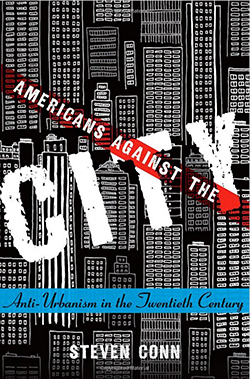 Americans Against the City: Anti-Urbanism in the Twentieth Century
Americans Against the City: Anti-Urbanism in the Twentieth Century
Steve Conn
Oxford University Press, 379 pages
Given the resilience (or revitalization, if you prefer) of many American cities in the face of the recent economic downturn, it would be natural to wonder if the young, well-educated populations moving to cities are aware of the fear, poverty, and anti-urban politics that beset cities throughout the 20th century. Ohio State University historian Steve Conn does not allow us to forget the anti-urban policies of the past with his book Americans Against the City; he also broadens the history of anti-urbanism with a surprising list of urban antagonists that reaches beyond the usual suspects.
Conn's first first anecdote of anti-urbanism stretches all the way back to William Penn in 1683. What follows is a relentless and often frustrating chronicle of the decay of urban centers and the eventual triumph of decentralization. Emerging from Conn's detailed historical and sociological analysis is a portrait of a country in a paradoxical relationship with its cities—despite the fundamental and powerful role of cities in the economic and social processes of the United States, the country has in turn treated cities like the bastard child of the political landscape.
Atlas of Cities
Edited by Paul Knox
Princeton University Press, 256 pages
More impressive than the taxonomy of cities that organizes this series of essays are the seemingly infinite visualizations deployed throughout. While the book's chapters range from ancient Greece to industrializing Manchester to celebrity-driven Los Angeles, the case for the spectacular diversity of cities is made most effectively by a unique infographic on seemingly every page. These are not old-fashioned bar graphs and pie charts—each infographic and map is animated and colorful as a reflection of the cities described.
The book is not an exhaustive and definitive atlas—it most certainly misses the mark at times, both by neglecting cities located in the global south and by allowing for too much superficiality in the text describing some of the cities under examination. But Atlas of Cities succeeds in a critical project in urbanism studies: improving the conversation about cities and civilization by investing in new methods of description.
 How Paris Became Paris: The Invention of the Modern City
How Paris Became Paris: The Invention of the Modern City
Joan DeJean
Bloomsbury USA, 320 pages
Joan DeJean proves that, when Paris is at issue, sometimes you have to throw political correctness out the window and just enjoy yourself. DeJean's history of 17th century Paris bends strongly toward decadence, glamour, and an odd combination of gentrification and public life. In so doing, she has written one of the finest urban histories to come along in many years.
Seventeenth century Paris probably has more in common with contemporary Paris than it does with its 16th century iteration. It was in that century that Paris went from being an agglomeration of villages to a unified metropolis. It was then that Paris became known as the City of Light, the city of love, and the city of all things fashionable. What DeJean does more convincingly than perhaps any scholar before her is to connect the culture of a city with its urban form.
DeJean would have you forget about Baron Haussmann. For her money, 17th century advances made Paris the gorgeous, urbane place that it is today. Some advances were technological, such as street lighting, public transportation, and retail display cases. Others were physical, including the three big ones: the first truly public square (Place des Vosges), then the world’s greatest piece of public infrastructure (the Pont Neuf), and the world’s first infill development (Ille San Louis). Add to that parks, shops, and domestic tranquility, and Paris became a united, relatively egalitarian city. The city was available to everyone, and it could be enjoyed and not merely inhabited. It gave rise to coquettes and bankers and fashion designers and artists, all, DeJean argues, unburdened by aristocratic hierarchy.
DeJean has a crucial lesson for planners: great cities do not just happen. They can be made. They just need to be made by people with good taste.
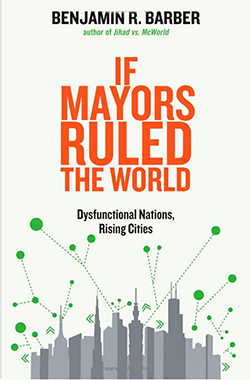 If Mayors Ruled the World: Dysfunctional Nations, Rising Cities
If Mayors Ruled the World: Dysfunctional Nations, Rising Cities
Benjamin R. Barber
Yale University Press, 416 pages
The received wisdom of the modern era has been that the nation-state is the natural unit of global political organization. Cities, though important, have none of the heft needed to gird the world order. Benjamin Barber reveals the lunacy of this claim. In a globalized world, states do not interact with states, which are “quintessentially indisposed to cooperation,” so much as cities interact with cities. In a politically polarized world, cities favor pragmatism over ideology. These macro- and micro-scale reasons prompt Barber to argue that mayors—not presidents, CEOs, or generals—can, should, and maybe already do "rule the world."
Barber evinces an encyclopedic knowledge of mayors the world over, some of whom are profiled in interstitial chapters that fall between his discussions of big themes: governance, connectivity, equity, culture, and others. Through all of it, Barber is optimistic, perhaps overly so, that true democracy and true social mobility can prevail in cities. He calls for cities to foster civil society and grassroots democracy, defends the primacy of public space, and discusses many of the challenges that face cities from Los Angeles to Lagos. Barber's trope about mayors' play for global dominance is most a cover for a discussion of the role of cities as a whole—not just their mayors—in the context of globalization. And yet, he concludes with a quite literal policy prescription for a global "assembly of mayors." As fanciful as it seems, it's tempting to think about how that body would operate as compared to say, the United Nations or—god forbid—the United States Congress.
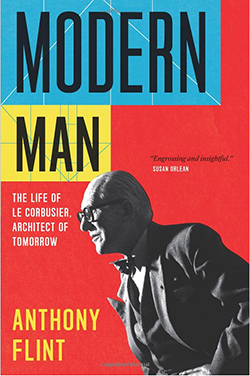 Modern Man: The Life of Le Corbusier, Architect of Tomorrow
Modern Man: The Life of Le Corbusier, Architect of Tomorrow
Anthony Flint
New Harvest, 258 pages
Anthony Flint, well know among Planetizen readers as the author of Wrestling with Moses and for his work with the Lincoln Institute of Land Policy, has written a new book on the "original starchitect," Le Corbusier. Although students of planning and architecture everywhere are sure to have strong opinions about his work, Le Corbusier might not have retained the same level of name recognition among the general public as Frank Lloyd Wright. Meanwhile, Le Corbusier's imprint is nearly unparalleled in the annals of city building, and his mission, to challenge the status quo of how cities are built, becomes more relevant with every instant megacity and gentrifying historic neighborhood.
Flint writes the story in narrative non-fiction to color the experience of the masterbuilder at work—a "biography of genius" as Flint has described the book. The narrative non-fiction style allows a broader access than a more academic or theoretical approach could. Given the power of his ideas, and the effect they had on cities everywhere, the benefit of Modern Man will come from demystifying of Le Courbusier's life, so that his work may be better understood. Although debate still rages about the consequences of Le Corbusier's work, none can debate the need for similar levels of ambition, creativity, and work ethic when it comes to the project of improving civilization.
 Paradise Planned: The Garden Suburb and the Modern City
Paradise Planned: The Garden Suburb and the Modern City
Robert A.M. Stern, David Fishman, and Jacob Tilove
Monacelli Press, 1072 pages
Usually when an architect compiles a book of seemingly impossible length you'd expect a certain (probably large) degree of futurist manifesto to be on the agenda. Yet architect Robert A.M. Stern, along with David Fishman and Jacob Tilove, conjured up a 1,000-plus-page gargantuan as an exhaustive study of an historic subject—namely the history of suburban planning before World War II. Media responded to this project perhaps that any other book released in the past year. Renowned critics like Allison Arieff and Witold Rybczynski provided reviews. The latter, in fact, stated that Paradise Planned is destined as the "prime source" on the subject of garden cities.
The book provides detailed analysis, complete with plan drawings, illustrations, and maps, of projects as far away as Brazil, Israel, Japan, and Australia. Many of the projects detailed in the book would have been difficult to find prior to the research of Stern's team. The agenda of all this historic analysis: to lay the foundation for a better future for suburbia.
U.K. Deputy Prime Minister Nick Clegg laid to rest the idea of the Garden City movement as a chapter in history books in April 2014, announcing the development of three new garden cities to combat the ongoing housing crisis in England. Stern's book is well timed, then, to provide perspective on the next garden city experiment.
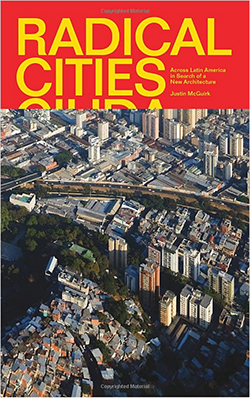 Radical Cities: Across Latin America in Search of New Architecture
Radical Cities: Across Latin America in Search of New Architecture
Justin McGuirk
Verso, 296 pages
Justin McGuirk unearths neglected examples of radical architecture around Latin America—a continent often left out of the discussions about urbanization. That neglect, as noted frequently by McGuirk, comes despite many of the countries in Latin America having urbanized earlier, and more completely, than many of the famously urbanizing countries in Asia and Africa.
Radical Cities reads as a travelogue—local personalities and the fine-grained details of places are described with care and respect. Also refreshing is the book's lack of "archispeak" even while describing tremendous accomplishments by the "activist architects" of McGuirk's fascination. McGuirk cites Alejandro Aravena in Chile, the firm Urban-Think Tank of Venezuela, and Teddy Cruz in San Diego, among others, as examples of architects thinking strategically and bridging the gap between the bottom-up processes of their communities with the institutional reach of governments. The "radical" project of Latin American cities, in McGuirk's telling, is more evolutionary than revolutionary.
 Ten Cities that Made an Empire
Ten Cities that Made an Empire
Tristam Hunt
Penguin, 544 pages
The city that Joseph Conrad described as "the biggest, and the greatest, town on earth" features hardly at all in Tristam Hunt's fresh take on the British Empire. Its role in the administering the British Empire and collecting its spoils is, apparently, too banal to mention. The British Empire was never really about islands, continents, or, in the case of India, sub-continents. It was about cities. While the spoils went to London, a constellation of cities provided the administrative and commercial hubs for the empire’s territories. Merchants, traders, slavemasters, and soldiers of the Empire found their fortunes not in "India" or "America" but rather in Mumbai and Boston.
Hunt treats the Empire gingerly. He takes his history seriously, reporting in measured tones, but he never hesitates to reveal the ugliness of his countrymen’s crimes against humanity. Hunt’s most riveting chapter, on Bridgetown, Barbados, describes in excruciating detail the mortal abuse of slaves who worked the sugar plantations and, briefly, made Bridgetown one of the world's richest cities. The empire's demise also turned Liverpool, once the shipbuilding capital of the world, into one of the poorest. And yet, there is no doubt that the British gave the world some of its great cities. Melbourne, Mumbai, and Hong Kong might never have existed were it not for the planting of the Union Jack, however unwelcome it might have been.
Ten Cities is not an inquiry into urban planning as such but an inquiry into urban networks. The British brought us the first iteration of globalization. May the next iterations be less full of horror.
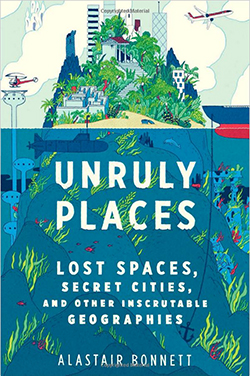 Unruly Places: Los Spaces, Secret Cities, and Other Inscrutable Geographies
Unruly Places: Los Spaces, Secret Cities, and Other Inscrutable Geographies
Alastair Bonnett
Houghton Mifflin Harcourt, 270 pages
For those with an unrelenting wanderlust in their hearts, Alastair Bonnett has produced a tome that will inspire hope that the world can still yield remarkable experiences in unexplored places. Bonnet's Unruly Place offers a collection of short essays exploring the world's geographic curiosities. From "No Man's Lands" to "Dead Cities" to "Ephemeral Places," the 47 essays explore places found in every unmapped corner of the world. Bonnett, a geography professor from Newcastle University, doesn't accept that exploration and discovery are obsolete in the era of Google Street View, and the reader is likely to complete the book inspire toward exploration of their own—either from the comfort of an armchair or, as Bonnett would probably prefer, with a trip outside.
According to this survey, unruly places aren’t always exotic or remote—sometimes they're a matter of perspective, available in our own backyards. Although the places in this book are described as inscrutable or mysterious, we hope an eye toward the elements that make these places remarkable might inform a discussion about how to infuse more mundane corners of the world with a bit of wonder, authenticity, and discovery.
 Why Place Matters: Geography, Identity, and Civic Life in Modern America
Why Place Matters: Geography, Identity, and Civic Life in Modern America
Edited by Wilfred McClay and Ted V. McAllister
Encounter Books, 297 pages
Why Place Matters responds to the threats to "place"—namely, that the modern American values of mobility and economic exchanges above all other considerations have robbed places of their potential as a benefit to the civic and cultural strength of communities. Editors Wilfred McClay and Ted V. McAllister gathered contributions from a distinguished crew of writers for an anthology that explores the many difficulties, and tremendous benefits, of a deep respect and understanding of place.
Included is an essay by poet Dana Gioia, for instance, writing about the detailed and emphatic opinions he encounters when discussing his hometown of Los Angeles. Other essays include a call for a new era in transportation planning and a scathing critique of the "cosmopolitanism" so common in the current conversations about cities and places. The essays are never overly difficult, even when the book's essays dare to take on subject matters that have confused readers and students of urbanism for as long as anyone can remember. An essay called "The Demand Side of Urbanism," for instance, is left to the capable exposition of Witold Rybczynski.
Although this book couldn't possible provide all of the data and rhetoric that will be needed to combat the powers currently marshaling to rob places of their soul, here's hoping that this book provides planners with the ammunition to fight the Amazon drones, and empty seas of surface parking spaces, with places worthy of admiration.

Plan to Potentially Remove Downtown Milwaukee’s Interstate Faces Public Scrutiny
The public is weighing in on a suite of options for repairing, replacing, or removing Interstate 794 in downtown Milwaukee.

‘Forward Together’ Bus System Redesign Rolling Out in Portland
Portland is redesigning its bus system to respond to the changing patterns of the post-pandemic world—with twin goals of increasing ridership and improving equity.

Can New York City Go Green Without Renewable Rikers?
New York City’s bold proposal to close the jail on Rikers Island and replace it with green infrastructure is in jeopardy. Will this compromise the city’s ambitious climate goals?

700-Acre Master-Planned Community Planned in Utah
A massive development plan is taking shape for lakefront property in Vineyard, Utah—on the site of a former U.S. Steel Geneva Works facility.

More Cities Ponder the End of Drive-Thrus
Drive-thru fast food restaurants might be a staple of American life, but several U.S. cities are actively considering prohibiting the development of new drive-thrus for the benefit of traffic safety, air quality, and congestion.

Air Pollution World’s Worst Public Health Threat, Report Says
Air pollution is more likely to take years life off the lifespan of the average human than any other external factor, according to a recent report out of the University of Chicago.
Placer County
City of Morganton
HUD's Office of Policy Development and Research
Dongguan Binhaiwan Bay Area Management Committee
City of Waukesha, WI
Los Angeles County Metropolitan Transportation Authority
Indiana Borough
Write for Planetizen
Urban Design for Planners 1: Software Tools
This six-course series explores essential urban design concepts using open source software and equips planners with the tools they need to participate fully in the urban design process.
Planning for Universal Design
Learn the tools for implementing Universal Design in planning regulations.



